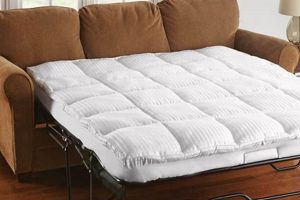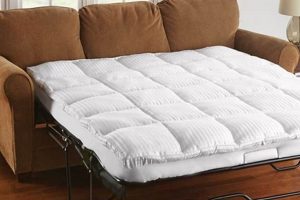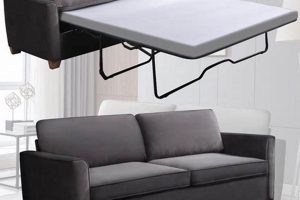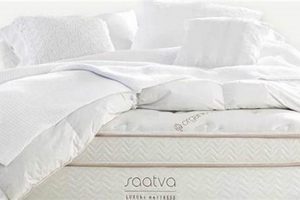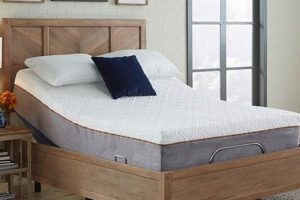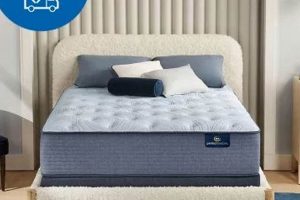The core concept involves a sleep surface specifically engineered to minimize spinal strain and maximize comfort for individuals who primarily sleep on their stomachs. These mattresses typically feature firmer support cores and carefully selected comfort layers to prevent excessive sinking and maintain proper spinal alignment throughout the night. The objective is to promote healthier sleep posture and reduce the likelihood of back or neck pain associated with this sleep position.
The value lies in addressing the unique challenges presented by prone sleeping. Traditional mattresses often lack the necessary support, leading to exaggerated spinal curvature and potential discomfort. Mattresses tailored for stomach sleepers aim to counter this by providing enhanced lumbar support and a balanced surface feel, ultimately contributing to improved sleep quality and reduced musculoskeletal issues. This specialization represents an evolution in mattress design, acknowledging the diverse needs of different sleep styles.
Therefore, subsequent discussion will delve into the key features that define suitable support systems, examine specific material considerations, and provide guidelines for selecting the correct firmness levels to optimize the sleep experience for individuals preferring the stomach position. This includes considering factors such as body weight, existing health conditions, and personal preferences.
Guidance for Optimal Stomach Sleeping Support
Selecting a mattress appropriate for stomach sleeping requires careful consideration of several factors to ensure proper spinal alignment and minimize potential discomfort.
Tip 1: Prioritize Firmness: A firmer mattress generally provides the necessary support to prevent excessive sinking of the hips and abdomen, which can lead to lower back strain. Medium-firm to firm options are often recommended.
Tip 2: Consider Hybrid or Innerspring Constructions: These mattress types typically offer enhanced support and responsiveness compared to softer foam-based mattresses. The coil systems provide greater resistance to compression, promoting spinal alignment.
Tip 3: Evaluate Edge Support: Strong edge support is crucial, especially for stomach sleepers who may shift positions during the night. A reinforced edge prevents sagging and provides a consistent sleeping surface.
Tip 4: Opt for Minimal Sinkage in Comfort Layers: While a slight degree of cushioning can enhance comfort, excessive sinkage in the top layers can negate the benefits of a firm support core. Look for mattresses with thinner comfort layers made of dense foam.
Tip 5: Assess Lumbar Support: Some mattresses incorporate enhanced lumbar support features, such as targeted zoning or additional coils in the center third of the mattress. These features can help maintain proper spinal alignment for stomach sleepers.
Tip 6: Research Material Breathability: Stomach sleeping can sometimes lead to increased body temperature. Mattresses with breathable materials, such as open-cell foam or natural fibers, can help regulate temperature and improve comfort.
Proper selection of a mattress intended for stomach sleeping contributes significantly to spinal health and overall sleep quality. By prioritizing firmness, support, and appropriate comfort levels, individuals can minimize the risks associated with this sleep position.
The subsequent section will address specific material considerations relevant to durability and longevity of mattresses designed for stomach sleepers.
1. Firmness and Support
Firmness and support are primary determinants of suitability in a mattress designed for stomach sleeping. The supine or lateral sleeper often benefits from a conforming surface that cradles the body, the stomach sleeper requires a greater degree of resistance to compression. Insufficient firmness leads to excessive sinking in the midsection, causing spinal misalignment and potential lower back pain. This effect is exacerbated by the concentration of body weight in the abdominal area when lying prone. Therefore, a mattress exhibiting adequate firmness resists this compression, maintaining a more neutral spinal posture. An example of this principle in practice is a mattress constructed with a high-density foam core and minimal top layer padding, which provides substantial support and prevents the hammock-like effect detrimental to stomach sleepers.
The practical significance of this relationship is evident in the prevalence of back pain among stomach sleepers using inappropriate mattresses. Studies have demonstrated that firmer sleep surfaces are associated with reduced incidence of lower back discomfort in this population. In contrast, softer mattresses often exacerbate existing conditions or contribute to the development of new musculoskeletal issues. Consequently, recommendations for stomach sleepers invariably emphasize the importance of selecting a mattress with a firm or medium-firm rating. These ratings correspond to specific indentation load deflection (ILD) values, which quantify the force required to compress the mattress material.
In summary, the link between firmness, support, and an optimal sleeping experience for stomach sleepers is undeniable. Selecting a mattress with sufficient firmness is not merely a matter of preference but a critical factor in maintaining spinal health and minimizing discomfort. Overcoming the challenge of finding the right balance between firmness and comfort requires careful consideration of individual body weight and preferences. This understanding directly informs purchasing decisions and contributes to improved sleep quality for those who prefer the stomach sleeping position.
2. Spinal Alignment Focus
Spinal alignment is a cornerstone of a suitable sleep surface, particularly crucial for individuals who prefer stomach sleeping. The prone position, without adequate support, often induces hyperextension of the lower back and rotation of the neck, leading to discomfort and potential long-term musculoskeletal issues. Therefore, a mattress designed for stomach sleepers must prioritize spinal alignment, minimizing these adverse effects. The direct consequence of neglecting this focus is persistent pain, disrupted sleep patterns, and decreased overall well-being. For instance, a mattress with reinforced lumbar support can actively counteract the tendency for the spine to sag, thereby maintaining a more neutral posture during sleep.
The importance of spinal alignment manifests in the specific design features incorporated into such mattresses. Zone support systems, for example, utilize varying densities of foam or coil configurations to provide targeted support to different regions of the body. The midsection, where stomach sleepers bear the most weight, receives increased support to prevent excessive sinking. Conversely, the shoulder area may feature slightly softer materials to accommodate the natural curvature of the body and reduce pressure points. An illustrative example is a hybrid mattress with individually pocketed coils, allowing for independent movement and contouring to the sleeper’s body while maintaining overall support.
In conclusion, the connection between spinal alignment and a mattress designed for stomach sleeping is undeniable. It addresses the postural challenges inherent in this sleeping position, promoting comfort, reducing pain, and fostering restorative sleep. The active integration of design elements focused on spinal support directly translates to improved sleep quality and long-term musculoskeletal health. Prioritizing this aspect when selecting a mattress is not merely a matter of comfort but a crucial investment in physical well-being.
3. Pressure Point Relief
While often associated with side-sleeping, pressure point relief remains a relevant, albeit nuanced, consideration in mattresses designed for stomach sleepers. The primary areas of concern are the ribcage, hip bones, and facial region, particularly when the sleeper rests their head to one side. Excessive pressure on these points can lead to discomfort, tossing and turning, and ultimately, disrupted sleep. The cause-and-effect relationship is direct: concentrated pressure leads to restricted blood flow and nerve compression, resulting in pain and restlessness. Even though the firmer support favored by stomach sleepers minimizes overall sinkage, localized pressure points can still develop, necessitating attention to the mattress’s surface comfort layers.
The importance of pressure point relief in this context lies in preventing secondary discomfort that detracts from the benefits of proper spinal alignment. A thin layer of conforming material, such as high-density memory foam or latex, strategically placed in the upper layers of the mattress can distribute weight and alleviate pressure on sensitive areas without compromising overall support. For example, a stomach sleeper who consistently experiences facial pressure may benefit from a mattress incorporating a zoned comfort layer, where the shoulder and head areas offer slightly more cushioning than the midsection. This targeted approach allows for both adequate support and localized pressure reduction. Practical application involves carefully evaluating the mattress’s construction, examining the density and composition of the comfort layers, and considering individual body contours and pressure sensitivities.
In conclusion, while not the dominant consideration, pressure point relief is an integral component of a complete mattress solution for stomach sleepers. By carefully balancing support with strategic pressure alleviation, manufacturers can create sleep surfaces that minimize discomfort, promote restful sleep, and enhance overall well-being. Addressing this facet requires a nuanced understanding of body mechanics and material properties, ensuring that the mattress meets the unique needs of individuals who prefer the stomach sleeping position. The challenge lies in achieving this balance without compromising the firm support essential for proper spinal alignment.
4. Breathability of materials
The breathability of materials plays a critical role in determining the suitability of a mattress, particularly for stomach sleepers. The prone position often results in increased body contact with the mattress surface, which can impede airflow and elevate body temperature. This can lead to discomfort, night sweats, and disrupted sleep patterns. The direct relationship is that reduced airflow traps heat, leading to a warmer sleep environment, which in turn negatively affects sleep quality. Therefore, materials with inherent breathability are crucial for dissipating heat and maintaining a comfortable sleep temperature. An example of this is the use of open-cell foam structures that allow for enhanced air circulation compared to traditional closed-cell foam.
The significance of breathable materials extends beyond mere comfort; it also contributes to the longevity and hygiene of the mattress itself. Improved airflow helps to prevent the build-up of moisture within the mattress layers, inhibiting the growth of mold, mildew, and bacteria. This is particularly important for stomach sleepers who may generate more body heat and moisture during sleep. Materials such as natural latex, organic cotton, and wool are often employed due to their inherent breathability and moisture-wicking properties. For example, a mattress constructed with a wool cover can effectively regulate temperature and wick away moisture, creating a drier and more hygienic sleep environment. The practical implication is a reduced risk of allergies and respiratory issues, along with extended mattress lifespan.
In summary, the breathability of materials is a key determinant of mattress quality for stomach sleepers. It directly impacts sleep comfort, hygiene, and mattress longevity. Selecting a mattress constructed with breathable materials is not merely a matter of preference but a crucial factor in promoting a cooler, drier, and healthier sleep environment. The challenge lies in balancing breathability with other important factors such as firmness and support, necessitating careful consideration of material composition and mattress construction. Prioritizing breathability when selecting a mattress contributes significantly to improved sleep quality and overall well-being.
5. Edge Support Quality
Edge support quality is a crucial but often overlooked component when considering a mattress suitable for stomach sleepers. The relationship stems from the tendency of individuals to utilize the entire sleep surface, often positioning themselves near the edge of the mattress. Insufficient edge support leads to compression and sagging along the perimeter, resulting in a feeling of instability and a tendency to roll off the mattress. This is particularly problematic for stomach sleepers, who require a consistent and stable surface to maintain spinal alignment and prevent twisting or straining of the neck and back. The immediate effect of inadequate edge support is a reduction in usable sleep surface and an increased risk of discomfort or injury.
The importance of robust edge support is further amplified by the inherent postural challenges associated with stomach sleeping. Individuals in this position often extend their limbs towards the edge of the mattress, placing additional stress on the perimeter. Mattresses with reinforced edges, typically achieved through the use of high-density foam encasements or strategically placed coils, resist compression and provide a stable platform. Consider, for instance, a mattress utilizing a “Quantum Edge” coil system, where the perimeter coils are firmer and more densely packed than those in the center. This design effectively prevents edge sagging, ensuring consistent support and allowing the stomach sleeper to utilize the entire surface without compromising spinal alignment. Furthermore, robust edge support facilitates easier ingress and egress from the bed, a significant consideration for individuals with mobility limitations.
In summary, the quality of edge support directly impacts the suitability of a mattress for stomach sleepers. It contributes to a stable and consistent sleep surface, minimizing the risk of discomfort and promoting proper spinal alignment. Selecting a mattress with enhanced edge support is not merely a matter of preference but a practical consideration that enhances sleep quality and overall well-being. The challenge lies in identifying mattresses that effectively balance edge support with other essential features, such as firmness and breathability, requiring careful evaluation of construction and materials. Prioritizing edge support is a strategic investment that maximizes the usable sleep surface and minimizes the potential for postural strain.
6. Material Durability
Material durability is a critical factor when selecting a mattress designed for stomach sleeping. The prolonged use and consistent pressure exerted on the sleep surface necessitate robust materials capable of withstanding compression and wear without significant degradation. The longevity and performance of the mattress are directly tied to the quality and resilience of its constituent components.
- Core Support Resilience
The core of a stomach sleeping mattress often utilizes high-density foam or innerspring systems to provide the necessary firmness and support. The long-term performance hinges on the ability of these materials to resist permanent deformation and maintain their structural integrity under continuous pressure. For instance, a high-density polyurethane foam core will retain its shape and support properties for a longer duration than a low-density alternative, preventing sagging and ensuring consistent spinal alignment.
- Comfort Layer Resistance to Compression
While stomach sleeping mattresses typically feature thinner comfort layers, the materials used in these layers must also exhibit resistance to compression. Repeated compression can lead to a loss of loft and diminished pressure relief over time. Materials such as latex or high-density memory foam are often preferred due to their ability to recover their original shape after repeated compression cycles, thereby maintaining a consistent level of comfort and support.
- Fabric Abrasion Resistance
The outer fabric of the mattress is subject to constant friction from bedding and body movements. Fabrics with high abrasion resistance, such as tightly woven cotton or synthetic blends, are essential for preventing tears, pilling, and premature wear. A durable fabric not only enhances the aesthetic appeal of the mattress but also protects the underlying layers from damage and contamination, contributing to its overall longevity.
- Seam and Stitching Strength
The seams and stitching of the mattress are critical points of vulnerability. Weak or poorly constructed seams can lead to separation and unraveling, compromising the structural integrity of the mattress and accelerating wear. Reinforced seams and high-quality stitching are essential for withstanding the stresses of regular use and maintaining the mattress’s shape and form over an extended period.
In conclusion, material durability is inextricably linked to the overall value and performance of a stomach sleeping mattress. Selecting a mattress constructed with resilient and durable materials ensures long-term support, comfort, and hygiene, representing a sound investment in sleep quality and physical well-being. Careful consideration of core support resilience, comfort layer resistance to compression, fabric abrasion resistance, and seam/stitching strength are essential for maximizing the lifespan and utility of the sleep surface.
Frequently Asked Questions
The following section addresses common inquiries concerning mattress selection for individuals who primarily sleep on their stomachs. Information provided is intended to clarify key considerations and inform purchasing decisions.
Question 1: Is a firm mattress always necessary for stomach sleeping?
While a firmer mattress is generally recommended, the ideal firmness level is contingent on individual body weight and build. Lighter individuals may find a medium-firm mattress provides adequate support, whereas heavier individuals typically require a firm or extra-firm option to prevent excessive sinking and maintain spinal alignment.
Question 2: Are memory foam mattresses suitable for stomach sleepers?
Traditional memory foam mattresses may not provide sufficient support for stomach sleepers due to their tendency to conform closely to the body, potentially leading to spinal misalignment. However, hybrid mattresses incorporating a supportive coil system with a thin layer of high-density memory foam can offer a viable alternative, balancing comfort and support.
Question 3: How does mattress thickness influence suitability for stomach sleeping?
Mattress thickness is less critical than firmness and support. A thicker mattress does not necessarily equate to better support. Focus should remain on the density and construction of the core support system, which is primarily responsible for maintaining spinal alignment.
Question 4: What role does pillow selection play in optimizing sleep posture for stomach sleepers?
Pillow selection is crucial. A very thin or no pillow is often recommended to minimize neck strain. A thick pillow can force the neck into an unnatural angle, exacerbating discomfort. A specialized stomach sleeping pillow, designed to maintain neutral alignment, may also be beneficial.
Question 5: How can a mattress topper improve an existing mattress for stomach sleeping?
A firm mattress topper can provide an additional layer of support to an existing mattress that is too soft. Options made of dense foam or latex are preferable. However, a topper cannot compensate for a fundamentally unsupportive mattress, and replacement may be necessary in such cases.
Question 6: What specific certifications indicate mattress quality and safety for stomach sleepers?
Certifications such as CertiPUR-US (for foam composition) and OEKO-TEX Standard 100 (for textile safety) indicate that the mattress has been tested for harmful substances and meets certain safety standards. These certifications do not guarantee suitability for stomach sleeping, but they provide assurance regarding material quality and potential allergen content.
In summary, selecting an appropriate mattress for stomach sleeping requires careful consideration of individual needs and preferences, prioritizing firmness, support, and spinal alignment. Consulting with a healthcare professional or sleep specialist can provide further guidance.
Conclusion
The preceding analysis underscores the multifaceted considerations essential in selecting a sleep surface optimized for prone sleep. Key factors, including firmness, spinal alignment focus, pressure point relief, material breathability, edge support quality, and material durability, each contribute significantly to the overall suitability of a mattress. Failing to address these elements can result in compromised spinal health, disrupted sleep patterns, and diminished well-being. The ideal best stomach sleeping mattress therefore represents a strategic convergence of design features and material properties tailored to the specific needs of this sleep style.
The selection of the appropriate mattress is an investment in long-term physical health. Individuals are advised to carefully evaluate their specific requirements, consult with relevant professionals if necessary, and prioritize quality and construction when making a purchasing decision. The objective is to cultivate a sleep environment that promotes restorative rest and minimizes the potential for musculoskeletal discomfort.


